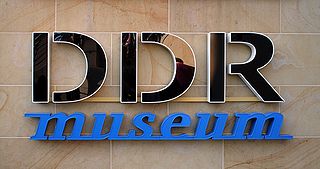 W
WThe Allied Museum is a museum in Berlin. It documents the political history and the military commitments and roles of the Western Allies in Germany – particularly Berlin – between 1945 and 1994 and their contribution to liberty in Berlin during the Cold War era.
 W
WThe Borderland Museum Eichsfeld is a history museum located in Central Germany at the former inner-German border between East and West Germany. It deals with the Cold War in general and the German division in specific.
 W
WThe Checkpoint Charlie Museum is a private museum in Berlin. It is named after the famous crossing point on the Berlin Wall, and was created to document the so-called "best border security system in the world". On display are the photos and related documents of successful escape attempts from East Germany, together with the escape apparatus: hot-air balloons, getaway cars, chairlifts, and a mini-U-boat. The museum researches and maintains a list of deaths at the Berlin Wall. It is operated by the Mauermuseum-Betriebs gGmbH, and the director is Alexandra Hildebrandt.
 W
WThe DDR Museum is a museum in the centre of Berlin. The museum is located in the former governmental district of East Germany, right on the river Spree, opposite the Berlin Cathedral. The museum is the 11th most visited museum in Berlin.
 W
WThe Gedenkstätte Berliner Mauer commemorates the division of Berlin by the Berlin Wall and the deaths that occurred there. The monument was created in 1998 by the Federal Republic of Germany and the Federal State of Berlin. It is located on Bernauer Straße at the corner of Ackerstraße and includes a Chapel of Reconciliation, the Berlin Wall Documentation Centre, a 60-metre (200 ft) section of the former border, a window of remembrance and a visitor center.
 W
WThe Government Bunker (Regierungsbunker) in Germany, officially named Ausweichsitz der Verfassungsorgane des Bundes im Krisen- und Verteidigungsfall zur Wahrung von deren Funktionstüchtigkeit (AdVB), in English: "Emergency Seat of the Federal Constitutional Organs for the State of Crisis or State of Defence to Maintain their Ability to Function" was a massive underground complex built during the Cold War era to house the German government, parliament and enough federal personnel needed to keep the government working in the event of war or severe crisis. Located only about 25 kilometres (16 mi) south of Bonn, Germany, in the Ahr Valley between the towns of Ahrweiler and Dernau, it was one of the best kept secrets of West Germany. It was built between 1960 and 1972 inside two abandoned railway tunnels that were built as part of the Strategic Railway, maintained and kept in a working condition for about 30 years and decommissioned in 1997. A small part of the once-secret site is now open to the public as Government Bunker Documentation Site, while the vast majority is abandoned and sealed.
 W
WHarnekop Nuclear Bunker is a former atomic bomb-proof bunker in the village of Harnekop in Prötzel, in the district Märkisch-Oderland, Brandenburg, Germany. Built over a 5-year period starting in 1971, the structure was the main bunker for the East German Ministry of National Defence and the National People's Army in case of a nuclear attack on the country.
 W
WThe KGB Prison at Leistikowstraße 1 in the German city of Potsdam was a detention centre run by the Soviet counter-intelligence organisation, SMERSH.
 W
WMödlareuth is a German village situated partly in Bavaria and partly in Thuringia. Between 1949 and 1990, the northern part was in East Germany and the southern part in West Germany. The Thuringian part of the village belongs to Gefell while the Bavarian part belongs to Töpen. It was called "Little Berlin" by the Americans because a wall divided it until 1989, like the Berlin Wall divided Berlin. "Little Berlin" became a symbol of separation between the West and East by the wall, but also a symbol of reunification. Today the Museum Mödlareuth shows the history of the village and gives information about the political system at that time.
 W
WThe Stasi Museum is a research and memorial centre concerning the political system of the former East Germany. It is located in the Lichtenberg locality of Berlin, in the former headquarters of the Stasi, on Ruschestraße, near Frankfurter Allee and U-Bahn station Magdalenenstraße.
 W
WThe Tränenpalast is a former border crossing point between East and West Berlin, at Berlin Friedrichstraße station, which was in operation between 1962 and 1989. It is now a museum with exhibitions about Berlin during the Cold War period and about the process of German reunification. It was the border crossing for travellers on the S-bahn, U-bahn and trains going between East and West Germany. It was used only for westbound border crossings. It had separate checkpoints for West Berliners, West Germans, foreigners, diplomats, transit travellers and East Germans.
 W
WVilla Schöningen is a historic residence in the city of Potsdam, Germany, located at Berliner Straße 86 at the corner with Swan Avenue just west of the Glienicke Bridge, which leads to Berlin.